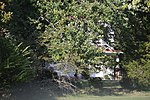Fort Lee Air Force Station
1956 establishments in Virginia1983 disestablishments in VirginiaAerospace Defense Command military installationsInstallations of the United States Air Force in VirginiaMilitary installations closed in 1983 ... and 3 more
Military installations established in 1956Radar stations of the United States Air ForceUse American English from January 2024

Fort Lee Air Force Station is a former United States Air Force station. It is located 2.9 miles (4.7 km) northwest of Prince George, Virginia. It was closed in 1983 due to budget cuts.
Excerpt from the Wikipedia article Fort Lee Air Force Station (License: CC BY-SA 3.0, Authors, Images).Fort Lee Air Force Station
1st Street,
Geographical coordinates (GPS) Address Nearby Places Show on map
Geographical coordinates (GPS)
| Latitude | Longitude |
|---|---|
| N 37.252222222222 ° | E -77.3225 ° |
Address
1st Street
23801
Virginia, United States
Open on Google Maps





